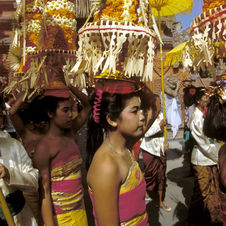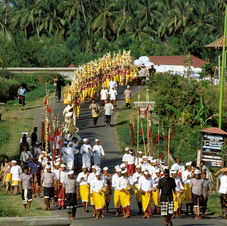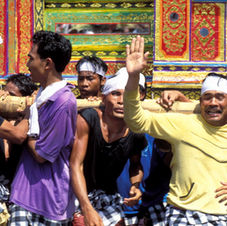INDONESIA : Cremation of the last Raja of Bali
Up in Flames
Text & Photography by Eric Pasquier
"Strange as it seems, it is in their cremation ceremonies that the Balinese have their greatest fun,” wrote the Mexican artist Miguel Covarrubias and his words are all the truer when a royal dies. The cremation ceremony is eight days long, the festivities take months of preparation by a hundred thousand locals and towering effigies are sculpted – only to be thrown on the pyre. ERIC PASQUIER discovers how Bali’s royal funerals reflect its unique mélange of cultures.Gongs sound throughout the village, thousands of people wind through the streets bearing offerings to the gods in a procession that will end at three great funeral pyres and the cremation of six Balinese royals. In the small town of Gianyar on the island of Bali, the raja Ide Anak Agung Gde Agung bid farewell to his mother, his late wife, mother, step-mother and three consorts of his father in a royal cremation ceremony that is a fascinating symbol of traditional Hindu Balinese culture.
The cycle of life, death and rebirth lies at the heart of Balinese Hinduism. Death is a celebration, the beginning of the soul’s return to panca mahabhuta (the five elemental substances): air, earth, fire, water and space.
Balinese Hindu’s believe that the soul escapes upon death but continues to linger until the body is burned. Cremation of the corporeal shell releases the soul, which once set free begins the journey of reincarnation. Unlike traditional western religions that cherish the body as a creation of God and a vessel for the soul, Balinese Hinduism treats the body as a temporary encumbrance to the soul’s journey toward the final state of bliss- nirvana. Cremation thus, is a joyous occasion and is considered to be the greatest day of a person’s life
For descendants of the deceased, cremation is the greatest gift they can give their loved one and is equally important for their own well-being. The cremation ritual is actually the final in a series of ceremonies collectively known as Pitra Yadnya. It is important that each ceremony is properly performed according to a strict set of rituals. Failing to carry out the rituals correctly can render the soul a ghost, capable of wrecking havoc on neglectful descendants.
Cremation rituals, however, can be costly undertakings for a family, and therefore are often carried out years after a person has died. Corpses of ordinary people are usually buried until such time as the family can afford the final ritual. However, in royal cremation ceremonies, such as the one in Gianyar, abstract effigies representing the deceased are cremated in place of the bodies. The bodies of royalty are considered too “pure” to be soiled by the earth and are immediately burned after death.
While it is now more common for ordinary people to cremate their dead, a cremation ceremony like the one in Gianyar, (the estimated total cost was well over €100.000) is solely the province of royalty.
The ceremony, the most elaborate in living memory, was given by Raja Ide Anak Agung Gde Agung, son of Raja Anak Agung Gde Agung for whom the last great royal cremation ceremony was held in the early 1960’s.
Agung was fearful that mass tourism in Indonesia was threatening the traditional culture and values of the Balinese people. This ornate celebration was not only meant as a fitting send-off for his relations but also as a reminder to his people of the three governing principle of Balinese life: religion, tradition and culture.
Preparations for the elaborate pelebon (cremation) ceremonies are lengthy and entail a great deal of time and money. The royal cremation in Gianyar involved the help of almost 60,000 people from 37 nearby villages and could not have been possible without their contributions. That so many villages were willing to contribute to the ceremony was an indication of the power and respect that the raja still commanded in the region, despite years spent living outside of Indonesia.
Gongs ring out and loud music sounds throughout the village, crowds fill the small streets of Gianyar signalling the start of the procession that will lead to the final cremation ceremony.
Traditionally the procession to the cremation site is made up of “labourers’ carrying bamboo platforms stacked with bade (funeral towers). The procession in Gianyar featured some of the most ornate constructions ever created. The richly carved and decorated funeral towers were made up of 11 tiers representing the Balinese universe and included a bale balean, a special place for the effigies. Huge sarcophagi carved in the shape of bulls (bulls are the symbol of the highest caste and reserved for royalty) were also a significant part of the procession- later the effigies would be placed in hollowed out areas of the sarcophagi for the final cremation.
Perhaps the most impressive part of the procession in Gianyar were the fantastic Naga Bandas (dragons) the largest of which measured over three metres in height. It took hundreds of men to carry the enormous serpents through the streets. The Naga Bandas are the guards of the underworld and guide any evil remaining in the body back down to hell.
They are reserved as guardians for princes and present only at royal cremation ceremonies.
The towers are carried three times around three funeral pyres.
The effigies of Raja Ide Anak Agung Gde Agung’s loved ones are transferred from the funeral tower to the cremation platform, where they are exposed, sprinkled in holy water and lifted into the bull-shaped sarcophagi. The Naga Bandas are brought down from their platforms and placed over the sarcophagi of Agung’s late wife, mother and step-mother. Final blessings are said and offerings are made to gods for the release of the soul.
Doused in coconut oil, once set aflame, the light combustible wood of the sarcophagi is consumed quickly by fire and the elaborate cremation structures are reduced to ashes.
But there is no grief, rather a joyous cry of celebration resounds through the crowd as the souls of the dead are released on their journey to nirvana.






















